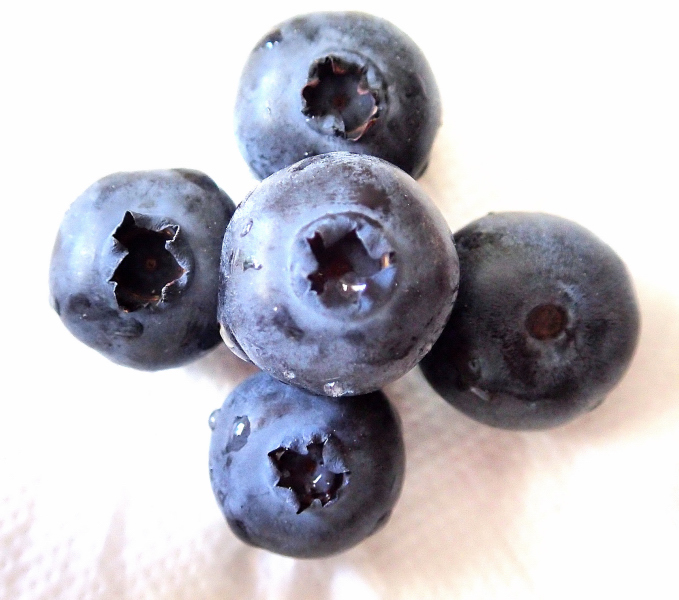| "Descrizione" by Nat45 (5724 pt) | 2020-Nov-27 15:23 |
Review Consensus: 18 Rating: 9 Number of users: 2
| Evaluation | N. Experts | Evaluation | N. Experts |
|---|---|---|---|
| 1 | 6 | ||
| 2 | 7 | ||
| 3 | 8 | ||
| 4 | 9 | ||
| 5 | 10 |
Sometimes, the most common fruits of the forest berries are those that improve our health. The blueberry is a very common berry found in the woods up to an altitude of 2,000 metres. It is rich in flavonoids.

Foods rich in flavonoids were shown to be able to reverse age-related cognitive deficits in both memory and learning in animals and humans. This study suggested that the consumption of blueberries rich in flavonoids had a positive impact on learning performance in healthy young animals, and these improvements were related to the activation of related signals of extracellular kinase (ERK), response element-binding protein (CREB), and a brain neurotrophic factor pro- and mature- (BDNF) pathway in the hippocampus (1).
Another study that focused on the memory of children between 8 and 10 years old, found that taking blueberry drinks, although with mixed results, improved memory by making the children recognize objects more effectively (2).
Other studies, this time in laboratory animals, confirmed the effectiveness of both the strawberry and the blueberry on cognition, motor behaviour and neuronal function (3).

In a comparison of various fruits of the forest berries including blackberries, blackcurrants and blueberries, the highest total of antioxidant capacity belonged to the blackberry, while the blackcurrant, despite having the highest total content of anthocyanins, had a lower antioxidant capacity. The blueberry, which had the main anthocyanins derived from malvidin derivatives, had lower antioxidant capacity (4).
The properties of the blueberry to protect the eyes were investigated, and it was found that some components in the berry, quercetin and rutin, were found to be effective in preventing cataractogenesis (5).
As shown by this study, the blueberry was recognised for its protective properties against inflammation and various diseases, particularly for the eyes and eye disorders, which shows the ability to protect the human cornea from inflammation and oxidative stress (6).

Anthocyanins present in blueberries, strawberries and blackberries contribute to eye health and have an antioxidant, anti-angiogenic and anti-aging action in RPE cells (Retinal Pigmented Epithelium cells) and are a useful healthy food for the prevention of retinal diseases (7).
RPE cells are vital for retinal health. However, they are susceptible to injury with aging and exposure to excessive light, including UV (100-380 nm) and visible radiation (380-760 nm). To assess the protective effect of the blueberry with its anthocyanins on RPE cells, in vitro cell models were created that replicated both senescence and light-induced damage. After purification and fractionation, extracts of anthocyanins (BAE) from blueberries were used in this study. The results demonstrated the effectiveness of BAEs against senescence and light-induced damage to RPE cells (8).
References_________________________________________________
(1) Blueberry supplementation induces spatial memory improvements and region-specific regulation of hippocampal BDNF mRNA expression in young rats. Rendeiro C, Vauzour D, Kean RJ, Butler LT, Rattray M, Spencer JP, Williams CM. Psychopharmacology (Berl). 2012 Oct;223(3):319-30. doi: 10.1007/s00213-012-2719-8.
(2) Effects of a single dose of a flavonoid-rich blueberry drink on memory in 8 to 10 y old children. Whyte AR, Williams CM. Nutrition. 2015 Mar;31(3):531-4. doi: 10.1016/j.nut.2014.09.013.
Cognitive effects following acute wild blueberry supplementation in 7- to 10-year-old children. Whyte AR, Schafer G, Williams CM. Eur J Nutr. 2015 Oct 5.
(3) The beneficial effects of berries on cognition, motor behaviour and neuronal function in ageing. Shukitt-Hale B, Bielinski DF, Lau FC, Willis LM, Carey AN, Joseph JA. Br J Nutr. 2015 Nov 28;114(10):1542-9. doi: 10.1017/S0007114515003451.

(4) Contribution of Anthocyanin Composition to Total Antioxidant Capacity of Berries. Lee SG, Vance TM, Nam TG, Kim DO, Koo SI, Chun OK. Plant Foods Hum Nutr. 2015 Dec
(5) Quercetin glycosides and chlorogenic acid in highbush blueberry leaf decoction prevent cataractogenesis in vivo and in vitro: Investigation of the effect on calpains, antioxidant and metal chelating properties. Ferlemi AV, Makri OE, Mermigki PG, Lamari FN, Georgakopoulos CD. Exp Eye Res. 2016 Apr;145:258-68. doi: 10.1016/j.exer.2016.01.012.
(6) Blueberry Component Pterostilbene Protects Corneal Epithelial Cells from Inflammation via Anti-oxidative Pathway. Li J, Ruzhi Deng, Hua X, Zhang L, Lu F, Coursey TG, Pflugfelder SC, Li DQ. Sci Rep. 2016 Jan 14;6:19408. doi: 10.1038/srep19408.
(7) The protective effects of berry-derived anthocyanins against visible light-induced damage in human retinal pigment epithelial cells. Wang Y, Zhang D, Liu Y, Wang D, Liu J, Ji B. J Sci Food Agric. 2015 Mar 30;95(5):936-44. doi: 10.1002/jsfa.6765.
(8) Blueberry anthocyanins: protection against ageing and light-induced damage in retinal pigment epithelial cells. Liu Y, Song X, Zhang D, Zhou F, Wang D, Wei Y, Gao F, Xie L, Jia G, Wu W, Ji B. Br J Nutr. 2012 Jul 14;108(1):16-27. doi: 10.1017/S000711451100523X.
| Evaluate |

